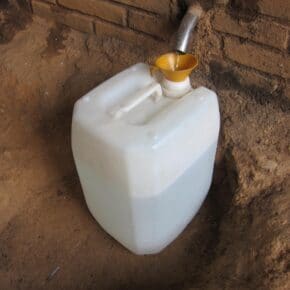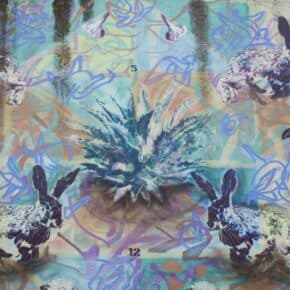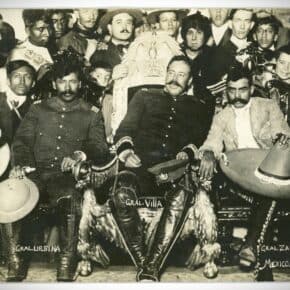Las Almas Rotas’ Shad Kvetko stumbled across an article from 1902 about Bacanora in The Oasis, a newspaper in Nogales, Arizona that might just be the first one explaining what is Bacanora. He transcribed it for us below.
Mezcal Manufacture: An important industry in Mexico, yielding a valuable product
May 24th, 1902
The traveler in the mountain regions of Sonora and other parts of Mexico, chances frequently upon spots where the wild maguey plants have been uprooted and stripped of their slender acicular pointed leaves, the latter scattered upon the ground about, while the great bulb from which they were stripped, has been carried away. Farther along the trail, he may overtake two or three Mexicans, with several burros, the latter later laden, with the big white bulbs of the maguey, which they have gathered in the surrounding mountains, and are packing to the nearest “Vinateria”, or mezcal distillery. These the traveler will find upon nearly every water course. Usually, and in the mountains, generally these mezcal distilleries are very primitive affairs, each one with a daily capacity of about 30 gallons of finished product; and for the material the mountain “vinateria” depend upon the wild maguey, growing all over the mountain region. In the valleys, there are frequently great plantations where several hundred acres will be cultivated to the maguey plant. And distilling operations are conducted on a grand scale.
The engraving upon this page presents a maguey plantation near Guayamas. The product of the wild maguey is usually considered superior. There is something in the combination of soil and water in those regions, which give them a scale, they produced a superiority and a reputation such as that enjoyed by whiskey made in certain parts of Kentucky. Although even in the mountain regions there is made an inferior mezcal, distilled from the “lechuguilla”, a plant of the maguey species, but somewhat different in general appearance. Its leaves are brighter than those of the maguey and their edges are serrated. The true maguey plant is more familiarly known in the United States as the “century plant”, from the long period of growth before it begins to bloom.
As already intimated, the mountain “vinateria” is a very primitive affair. The still is set at a convenient place besides a mountain spring or stream from which the necessary water can be readily and conveniently drawn by hand or with a rude pump. Near at hand are a number of huge depressions hollowed in the ground, in the shape of a butter bowl, each from 12 to 14 feet in diameter and 3 to 4 feet deep in the center, rudely lined with smooth, flat stones of large size, gathered from the bed of the stream nearby. These the raw bulbs of the plant are roasted by nearly filling the great bowls with the bulbs and building fires upon the top of the heaps. When roasted, the bases of the segregated leaves, which in the raw state are not noticeable, have separated from the center stock and the bulb which in roasting has become cafe au lait in color, somewhat resembles a huge artichoke. The leaf bases are then easily stripped from the stock, and at the joints is a soft, succulent, sweet pith, of which the people are very fond as an edible. But the entire leaf base is shredded and put into the fermenting vats, where the period of fermentation extends through 15 days.
The fermenting vats are very crude affairs, each is made of the untanned hide of an ox. On a square frame, the edges of the hide are lashed with rawhide thongs and the frame is set into the crotch tops of four uprights set into the ground. Each upright is about 3 feet high, and the center of the hide hangs within a few inches of the ground. Each of these vats will hold the charge of the still for one day’s run, so there are always 15 or 16 of them at each “vinateria”. During the first few days of fermentation the pomace lies in the open air, and is daily turned and trodden by barefooted men. Then it is covered with earth to the depth of about a foot, and fermentation proceeds until the 16th day, when the pomace is transferred to the still.
The first run from the still is a very crude and fiery liquor, and is called “vino”. This is, of course, the cheapest kind, and requires a steel lined stomach and bowels to appreciate it. But usually the “vino” is run through the still a second time, losing 30% by weight. This product is called “bacanora”, and is a milder liquor, but much stronger. Upon special orders this “bacanora” is then distilled, losing another 30% by weight. The product is named “pechuga”, and, while a smooth liquor, and pleasant to the pallet it is very potent. The mezcal distilling season usually extends through seven months, beginning in October and ending in May. At each “vinateria” there is always quite a little camp, the 30 or 40 workmen required having their families there during the season and all returning to the towns when the season is done.
While used as a beverage in Mexico, it is very valuable as a medicine. It’s action upon the heart is much quicker than any other form of alcohol. For which reason it is not the safest beverage that can be adopted. But used medicinally it is very valuable. It is a diffusible stimulant, tonic, stomachie and diuretic. Taken medicinally it will greatly relieve stomach and liver troubles by stimulation of the gastric and hepatic secreting functions, and also kidney and bladder difficulties, complete cure of affections of these organs have been noted. In 1883 the writer went into the state of Jalisco, in the interior of Mexico, for three months where he could get nothing but tequila, which is their local appellation for “bacanora”. In three months time he was cured of a dyspepsia which had troubled him from the time he left the army in 1865. Never since has he been troubled with dyspepsia.
By anyone with the need to handle the business on a large scale, and advertise it extensively, a great fortune could be made by importing “bacanora” in the United States and selling it as a proprietary medicine.












Leave a Comment